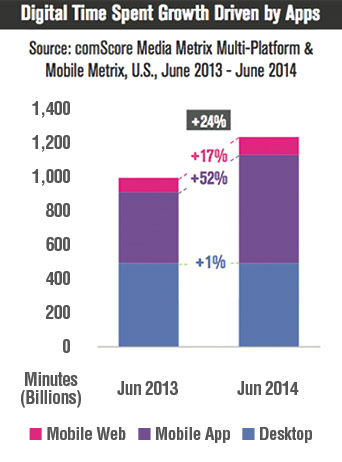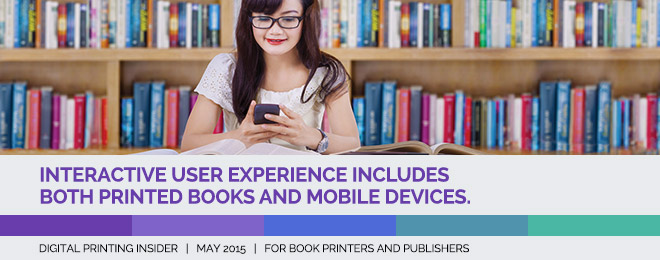Trends in Emerging Technologies for Book Content
Publishers know that they must grapple with media consumption shifting to mobile devices, but merely having a mobile focus is not enough. Mobile now accounts for the majority (60%) of all time spent on the web, with mobile apps themselves constituting 52% of all internet consumption. Although quick response (QR) codes are the most common type of mobile integration among consumers, other forms of mobile integration include near-field communication (NFC) tags and augmented reality (AR) technology.
Barb Pellow, Group Director at InfoTrends, states, “While book publishing has withstood the digital disruption better than other industries (for example, music or movies), it remains to be seen what the future holds. What we know now is that consumers are clicking through these mobile technologies to obtain additional information about products, take advantage of discounts, and bring their book reading to the next level.”
 A webinar entitled Emerging Technologies to Optimize Book Publishers’ Content Strategies was hosted by Book Business and Printing Impressions magazines and sponsored by Canon Solutions America. In this webinar, Pellow describes several examples of the mobile integration with books. Additionally, guest speakers Brett Cohen (President of Quirk Books) and Scott Jochim (CEO of Popar Toys) explore and share how their companies are leveraging these technologies to make books more interactive and engaging.
A webinar entitled Emerging Technologies to Optimize Book Publishers’ Content Strategies was hosted by Book Business and Printing Impressions magazines and sponsored by Canon Solutions America. In this webinar, Pellow describes several examples of the mobile integration with books. Additionally, guest speakers Brett Cohen (President of Quirk Books) and Scott Jochim (CEO of Popar Toys) explore and share how their companies are leveraging these technologies to make books more interactive and engaging.
Quirk Books publishes about 25 books per year, and its targeted audience is readers between the ages of 18 to 34 who live in urban areas and are always online. Brett Cohen elaborates, “Our audience is very much in tune with emerging technologies, and they care about things like design, packaging, and coolness.” Distributed worldwide by Penguin Random House, some of Quirk’s more popular recent titles include the bestselling young adult fantasy novel Miss Peregrine’s Home for Peculiar Children, the Edgar Award-winning mystery The Last Policeman, the legendary Pride and Prejudice and Zombies, and the classroom favorite William Shakespeare’s Star Wars. Addressing the topic of the digital revolution, Cohen notes, “Books have enjoyed a slower migration from physical to digital than other media types. We’ve always consumed music in roughly the same way… the player has changed but the experience hasn’t. The same holds true for movies and television. The shake-up in the industry has been largely attributable to the changes in the distribution and revenue models.” The digital transformation in the publishing world (for example, the transition to the ebook) has been a bit different. Recent innovations have expanded beyond just the evolution in distribution and revenue models. The way content is being created and consumed is opening new opportunities for publishers. Cohen continues, “The printed world is no longer static, so the book no longer needs to be a linear experience.” During the webinar, Cohen goes on to describe how Quirk Books is experimenting with a number of new technologies to entice readers to explore titles through interactivity.
“The printed world is no longer static, so the book no longer needs to be a linear experience.”
BRETT COHEN, QUIRK BOOKS
Next, Scott Jochim of Popar Toys explains his business’ transition from a gaming company to a print publisher. He states, “We saw the opportunity that augmented reality brought to the market to bridge the gap between the physical and digital worlds, so we got into publishing starting with digital and jumping to printing.” Today, Popar changes the way that readers experience printed media through interactive AR-infused children’s products. The company’s books, puzzles, and charts are designed to engage readers with stories that come to life as interactive games occur in their own environments, helping children to learn and retain information. Popar brought its first book to life in 2012, and this brought an extreme amount of press and instant popularity among consumers. The item illustrated the power of cross-branding—it was a book as well as a toy—and it ultimately won best toy and best book awards in 2012. During the webinar, Jochim highlights how a physical book with AR enhancements takes on new life and becomes a learning tool. He elaborates, “The product becomes so much more than a book that literally pops with activities. It becomes something that is engaging as well as interactive.” These products provide new revenue and distribution opportunities; the employment of emerging software technologies restructures the book’s contents to accommodate more interactive and dynamic learning models. The webinar illustrates what companies like Popar have been able to do with AR.
Today’s new digital world is clearly creating a major market transformation in the book publishing industry. This change is being driven by the delivery system, which is making the transition from purely print to print and digital. Following Cohen and Jochim’s discussions, Pellow concludes the webinar with several not-to-be-missed takeaways. She explores the innovative ways that content is being delivered to accommodate consumers’ changing needs for an interactive experience.
